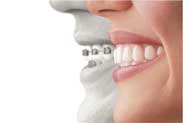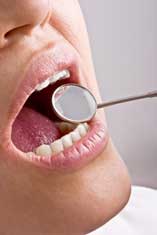your questions about children’s oral health. Have additional questions for us? Visit Frangella Dental on Facebook or Twitter.
 If it’s decided that your child needs orthodontic treatment, traditional braces are the most common way to straighten a child’s teeth from ages 8 to12 years old.
For teenagers, there is an alternative to braces called Invisalign. Invisalign moves the teeth using clear aligners. The clear aligners are removable so that they can be taken out for eating, drinking, and social events. In order for your child to be considered for Invisalign, his/her mouth must have fully transitioned from baby teeth to permanent teeth, which is typically complete by 12 years old for most children.
Because Invisalign is removable, teenagers may have compliance issues with the treatment. I often find teens with responsible personalities that truly do want to straighten their teeth to be the most successful with treatment.
For additional information on treatment options or to schedule a consultation, call us at (212) 245-2888.]]>
If it’s decided that your child needs orthodontic treatment, traditional braces are the most common way to straighten a child’s teeth from ages 8 to12 years old.
For teenagers, there is an alternative to braces called Invisalign. Invisalign moves the teeth using clear aligners. The clear aligners are removable so that they can be taken out for eating, drinking, and social events. In order for your child to be considered for Invisalign, his/her mouth must have fully transitioned from baby teeth to permanent teeth, which is typically complete by 12 years old for most children.
Because Invisalign is removable, teenagers may have compliance issues with the treatment. I often find teens with responsible personalities that truly do want to straighten their teeth to be the most successful with treatment.
For additional information on treatment options or to schedule a consultation, call us at (212) 245-2888.]]>
Andrew D. Frangella DDS, FICOI Receives 2011 Fellowship Award from the Academy of General Dentistry
NEW YORK (August 8, 2011)
The Academy of General Dentistry (AGD), a professional association of more than 37,000 general dentists dedicated to staying up to date in the profession through continuing education to better serve the public, is pleased to announce that Andrew D. Frangella DDS, FICOI, FAGD of Frangella Dental in New York, New York, received the association’s 2011 Fellowship award during the AGD 2011 Annual Meeting & Exhibits, held July 28 to 31 in San Diego, California. The Fellowship award is presented to dentists who seek to provide the highest quality of dental care by remaining current in their profession. To accomplish this goal, Dr. Frangella completed 500 hours of continuing dental education, passed a comprehensive exam and fulfilled three years of continuous membership in the AGD. As a recipient of the Fellowship award, Dr. Frangella joins more than 7,000 active AGD Fellows who understand that providing great smiles and good oral health for their patients are the result of going above and beyond basic requirements. “We are proud to honor Dr. Frangella for his commitment to the profession,” says AGD President Howard Gamble, DMD, FAGD. “He has distinguished himself professionally among his peers and demonstrates the characteristics of a role model to both his fellow dentists and to the members of the community.” Dr. Frangella graduated from New York University’s College of Dentistry in 2005 and currently practices general and cosmetic dentistry at Frangella Dental in Midtown, Manhattan.About the Academy of General Dentistry
The Academy of General Dentistry (AGD) is a professional association of more than 37,000 general dentists dedicated to staying up to date in the profession through continuing education to better serve the public. Founded in 1952, the AGD has grown to become the second largest dental association in the United States, and it is the only association that exclusively represents the needs and interests of general dentists. More than 772,000 persons in the United States are employed directly in the field of dentistry. A general dentist is the primary care provider for patients of all ages and is responsible for the diagnosis, treatment, management and overall coordination of services related to patients’ oral health needs. For more information about the AGD, please visit www.agd.org.About Frangella Dental
Frangella Dental is a Manhattan family practice of 3 siblings, Andrew D. Frangella DDS, FICO, FAGD, Tina M. Frangella DDS, and Laura O. Frangella, DDS, utilizing state-of-the-art technology and cutting-edge techniques to cover a broad spectrum of preventative & cosmetic dental procedures.]]>your questions about children’s oral health. Have a question for us? Visit Frangella Dental on Facebook.
When should I schedule my child’s first dental appointment?
As soon as a child’s teeth begin to erupt, they should start seeing a dentist. The goal is to bring your child early so that he/she gets accustomed to the environment and learns what to expect at the office and during a check-up.
It is also important to bring children early so that they can be evaluated for common dental issues such as baby bottle tooth decay and any problems with their bite for early intervention if necessary. 
What can we expect at our child’s first dental appointment? The first visit is all about getting acclimated to the dental office. Even if we only get as far as having the child sit in the chair and allow me to look with a mirror, it’s still considered a successful visit.
If you start your child at the right age and are performing proper home care, usually they will not need anything other than a routine cleaning and exam.
The first dental visit will include a cleaning and dental exam. X-rays typically are not taken until the age of 5 or 6 once the child begins to have eruption of their permanent teeth.
It is important to bring your child in every 6 months. This will help prevent future tooth decay but also hopefully get your child so comfortable with the dentist that they are actually excited to visit for their cleanings.
How can I ease my child’s anxiety of visiting the dentist?
It helps if a parent brings the child to one of their own cleanings prior to the child’s, so that he/she knows what to expect and can see the parent comfortable and at ease.
A parent should never use going to the dentist as a punishment (i.e. “If you don’t brush your teeth you’re going to go to the dentist and they’re going to give you a shot”).
Most importantly, be a good example. Children’s fear of the dentist is often a learned one. If you show you are afraid and anxious, it is likely that they will be afraid and anxious.
How do I choose a dentist that’s right for my child?
When evaluating dentists, you want to find one who regularly treats children. Besides their dental ability, it is equally important to find someone who your child will be comfortable with.
The way your child perceives their dentist and dental visit, often sets the tone for how they feel about the dentist as an adult. Therefore it is very important that you find the right doctor for your child. Often, a parent will find a dentist who they themselves are comfortable with and who also regularly treats children in their practice.]]>
How can I ease my child’s anxiety of visiting the dentist?
It helps if a parent brings the child to one of their own cleanings prior to the child’s, so that he/she knows what to expect and can see the parent comfortable and at ease. A parent should never use going to the dentist as a punishment (i.e. “If you don’t brush your teeth you’re going to go to the dentist and they’re going to give you a shot”). Most importantly, be a good example. Children’s fear of the dentist is often a learned one. If you show you are afraid and anxious, it is likely that they will be afraid and anxious.How do I choose a dentist that’s right for my child?
When evaluating dentists, you want to find one who regularly treats children. Besides their dental ability, it is equally important to find someone who your child will be comfortable with. The way your child perceives their dentist and dental visit, often sets the tone for how they feel about the dentist as an adult. Therefore it is very important that you find the right doctor for your child. Often, a parent will find a dentist who they themselves are comfortable with and who also regularly treats children in their practice.]]> A common question patients ask me is, “Am I at risk for oral cancer and what can I do to prevent it?”
 Oral cancer is a form of cancer that occurs in the mouth.
It most frequently presents on the tongue, soft palate (roof of the mouth), floor of the mouth, lips, and the gums.
Although the exact cause of oral cancer is unknown, there are known risk factors such as excessive exposure to the sun, tobacco, and alcohol. There is also research that suggests that some forms of oral cancer may be caused by the human papilloma virus (HPV).
A hallmark of our age is the hands on approach many Americans are taking with their health care. The advent of sites like WebMD have led to more educated and healthier patients. By avoiding known risk factors and being more aware of your general health, your doctors are better able to diagnose and treat health problems earlier.
Oral cancer is a form of cancer that occurs in the mouth.
It most frequently presents on the tongue, soft palate (roof of the mouth), floor of the mouth, lips, and the gums.
Although the exact cause of oral cancer is unknown, there are known risk factors such as excessive exposure to the sun, tobacco, and alcohol. There is also research that suggests that some forms of oral cancer may be caused by the human papilloma virus (HPV).
A hallmark of our age is the hands on approach many Americans are taking with their health care. The advent of sites like WebMD have led to more educated and healthier patients. By avoiding known risk factors and being more aware of your general health, your doctors are better able to diagnose and treat health problems earlier.
Tips to decrease your chances of oral cancer and/or catch it early:
- Be observant, if you see something that doesn’t look right in your mouth, get it checked out immediately. Oral cancer is typically painless in the early stages and is normally represented by red, white or discolored lesions, patches or lumps in or around the mouth.
- Avoid common rish factors such as smoking, excessive drinking, and excessive sun exposure.
- See your dentist regularly! Early diagnosis is key for oral cancer treatment. Ideally, you should be seeing your dentist every six months for routine checkups. During your oral cancer screenings, your dentist will check your neck, head, cheeks and oral cavity for any lumps, or irregular tissue changes
Frangella Dental
Offering advanced techniques in Cosmetic and General Dentistry in New York City.
200 W. 57th Street, Suite 1405
New York, NY 10019
(212) 245-2888
care@drfrangella.com
